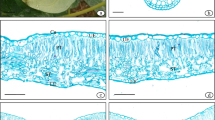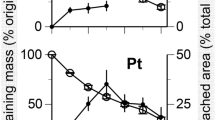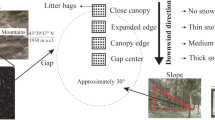Abstract
“OBSERVATION shows,” says Emile Mer, “that in most cases where wood dies in contact with living wood there is produced from the second towards the first a migration of starch and tannin, and (in a conifer) of resin; there is thus produced from the portions remaining living towards the dying or dead portions a drainage of substances, &c.” These remarks refer to the formation of secondary periderm and of the duramen, but their scope and tenour may perhaps, I think, be extended to the case of forest leaves approaching the end of their existence as living organs. How does it come to pass that in autumn the leaves of some of our forest trees exhibit a brilliant livery of crimson, while others exhibit only a yellow or golden glory? Take, for instance, the case of the ash constituents in the dry substance of the leaf. It is known by analysis that the percentage of ash increases through nearly the whole life of the leaf in beech, sycamore, elm, but not in oak, larch, cherry, &c.; it depends a good deal on whether some one ash constituent (generally lime or silica) is being steadily stored up. For example, the dry leaf of Acer campestre on May 1 has 6 per cent. ash, and in October 16.2 per cent. ash; the dry leaf of Prunus aviumhas on April 28, 7.8 per cent., and on October 2, 7.2 per cent. ash. Now the leaf of the former tree is only yellow in autumn and never red, while that of the latter is very often beautifully crimson. In the former case there is a kind of gradual decay or death of some of the cells (mostly of the upper epidermis) which occasions a drainage of mineral and organic substances to these parts from the still living tissues. This drainage and accumulation attest, in fact, such a decay; and what is more, they seem to have a distinct influence over the ultimate autumnal coloration of the leaf itself. It is easy to understand, in fact, that the leaves which exhibit such a decay and approach to dissolution are just these wherein the chromogen precursive of the brilliant red coloration would likewise suffer an analogous kind of change, i.e. it would tend to become brown, to produce phlobaphene, just as it does in the outer bark which is the practically dead portion of the rind. Where this accumulation of mineral matter and all which it implies does not take place, as in cherries, currants, American oaks, pears, wild vine, barberry, &c., then the chromogen does not deteriorate; it evolves its proper pigment, and assumes the flush and glow of active living colour. On the other hand, in elms, chestnut, linden, birch, poplars, &c., which are never red but only yellow, it is only the vivid carotin attached to the last faded and now exhausted chlorophyll which gleams forth, but only for a time, and if not too much obstructed by the dull browns of decomposed carbohydrates and superoxidised tannic chromogens.
This is a preview of subscription content, access via your institution
Access options
Subscribe to this journal
Receive 51 print issues and online access
$199.00 per year
only $3.90 per issue
Buy this article
- Purchase on Springer Link
- Instant access to full article PDF
Prices may be subject to local taxes which are calculated during checkout
Similar content being viewed by others
Author information
Authors and Affiliations
Rights and permissions
About this article
Cite this article
KEEGAN, P. Leaf Decay and Autumn Tints. Nature 62, 523–524 (1900). https://doi.org/10.1038/062523e0
Issue Date:
DOI: https://doi.org/10.1038/062523e0
Comments
By submitting a comment you agree to abide by our Terms and Community Guidelines. If you find something abusive or that does not comply with our terms or guidelines please flag it as inappropriate.



